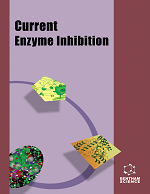- Home
- A-Z Publications
- Current Enzyme Inhibition
- Previous Issues
- Volume 8, Issue 2, 2012
Current Enzyme Inhibition - Volume 8, Issue 2, 2012
Volume 8, Issue 2, 2012
-
-
Novel Therapeutic Approaches to Regulate Human Dihydrofolate Reductase Activity and Expression
More LessDihydrofolate reductase (DHFR) enzyme catalyzes the reduction of dihydrofolate to tetrahydrofolate using NADPH as a cofactor to restore the reduced folate pools for reactions requiring one carbon transfer. Folates are required for de novo synthesis of purines and thymidylate, as well as glycine, methionine and serine. For this reason, DHFR has been an important target for chemotherapy for many diseases including canc Read More
-
-
-
Beyond Thymidylate Synthase and Dihydrofolate Reductase: Impact of Non-coding microRNAs in Anticancer Chemoresistance
More LessBy Jingfang JuChemoresistance is one of the major reasons for the failure of anticancer chemotherapy in treating advanced stage cancer. The mechanism of chemoresistance to fluoropyrimidines and antifolates has been extensively investigated in the past 40 years. It has been well established that thymidylate synthase (TYMS, TS) and dihydrofolate reductase (DHFR) are two major targets for fluoropyrimidines and antifolates, respec Read More
-
-
-
Structural Analysis of Dihydrofolate Reductase and Thymidylate Synthase from Mammalian and Pathogenic Organisms
More LessBy Vivian CodyThe ubiquitous enzyme dihydrofolate reductase (DHFR) is responsible for the reduction of 5,6-dihydrofolate to 5,6,7,8-tetrahydrofolate in an NADPH-dependent manner. The enzymes DHFR and thymidylate synthase (TS), which converts deoxyuridine monophosphate (dUMP) to deoxythymidine monophosphate (dTMP), are coupled in the folate pathway as the product of TS (dihydrofolate) is the substrate for DHF Read More
-
-
-
Recent Progress in Molecular Dynamics Simulations of Dihydrofolate Reductase
More LessAuthors: John E. Kerrigan, Emine Ercikan Abali and Joseph R. BertinoThis brief review will cover recent advances and applications of molecular dynamics simulations of dihydrofolate reductase over the course of the past few years. The application of the technique to the study of kinetic isotope effects, binding free energy of drugs, impact of ligand binding on protein conformation and study of coupled motions in hydrogen tunneling reactions will be discussed.
-
-
-
Targeting Folate Metabolism in the Human Malaria Parasite Plasmodium falciparum
More LessAuthors: John E. Hyde and Ingrid B. MullerHuman malaria parasites, in particular the most dangerous species, Plasmodium falciparum, are responsible for more than a million deaths per year, mainly of young African children, as well as causing enormous social and economic problems in endemic countries. In the absence of efficacious vaccines, the main weapon against malaria infections is intervention with drugs. Within the antimalarial drugs currently deplo Read More
-
-
-
Recent Advance in Isoform-Specific Regulation of Adenylyl Cyclase
More LessAuthors: David Wei-Kang Ho, Masanari Umemura, Claudio Bravo and Kousaku IwatsuboCyclic AMP is an ubiquitous molecule that serves as an important second messenger for multiple signaling pathways. At least nine membrane-bound mammalian isoforms of adenylyl cyclase have been identified, and each isoform has a distinct pattern of tissue distribution as well as interaction with regulatory proteins within local cytosolic environment. Adenylyl cyclase is coupled to G-protein receptors and serves to c Read More
-
Volumes & issues
-
Volume 20 (2024)
-
Volume 19 (2023)
-
Volume 18 (2022)
-
Volume 17 (2021)
-
Volume 16 (2020)
-
Volume 15 (2019)
-
Volume 14 (2018)
-
Volume 13 (2017)
-
Volume 12 (2016)
-
Volume 11 (2015)
-
Volume 10 (2014)
-
Volume 9 (2013)
-
Volume 8 (2012)
-
Volume 7 (2011)
-
Volume 6 (2010)
-
Volume 5 (2009)
-
Volume 4 (2008)
-
Volume 3 (2007)
-
Volume 2 (2006)
-
Volume 1 (2005)
Most Read This Month
Article
content/journals/cei
Journal
10
5
false
en


